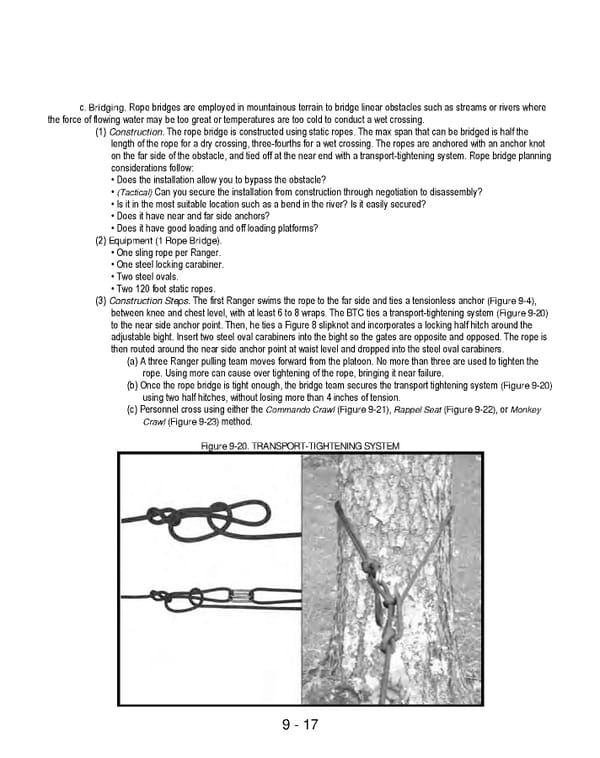9 - 17 c. Bridging. Rope bridges are employed in mountainous terrain to bridge linear obstacles such as streams or rivers where the force of flowing water may be too great or temperatures are too cold to conduct a wet crossing. (1) Construction. The rope bridge is constructed using static ropes. The max span that can be bridged is half the length of the rope for a dry crossing, three-fourths for a wet crossing. The ropes are anchored with an anchor knot on the far side of the obstacle, and tied off at the near end with a transport-tightening system. Rope bridge planning considerations follow: • Does the installation allow you to bypass the obstacle? • (Tactical) Can you secure the installation from construction through negotiation to disassembly? • Is it in the most suitable location such as a bend in the river? Is it easily secured? • Does it have near and far side anchors? • Does it have good loading and off loading platforms? (2) Equipment (1 Rope Bridge). • One sling rope per Ranger. • One steel locking carabiner. • Two steel ovals. • Two 120 foot static ropes. (3) Construction Steps. The first Ranger swims the rope to the far side and ties a tensionless anchor (Figure 9-4), between knee and chest level, with at least 6 to 8 wraps. The BTC ties a transport-tightening system (Figure 9-20) to the near side anchor point. Then, he ties a Figure 8 slipknot and incorporates a locking half hitch around the adjustable bight. Insert two steel oval carabiners into the bight so the gates are opposite and opposed. The rope is then routed around the near side anchor point at waist level and dropped into the steel oval carabiners. (a) A three Ranger pulling team moves forward from the platoon. No more than three are used to tighten the rope. Using more can cause over tightening of the rope, bringing it near failure. (b) Once the rope bridge is tight enough, the bridge team secures the transport tightening system (Figure 9-20) using two half hitches, without losing more than 4 inches of tension. (c) Personnel cross using either the Commando Crawl (Figure 9-21), Rappel Seat (Figure 9-22), or Monkey Crawl (Figure 9-23) method. Figure 9-20. TRANSPORT-TIGHTENING SYSTEM
 Ranger Handbook Page 184 Page 186
Ranger Handbook Page 184 Page 186